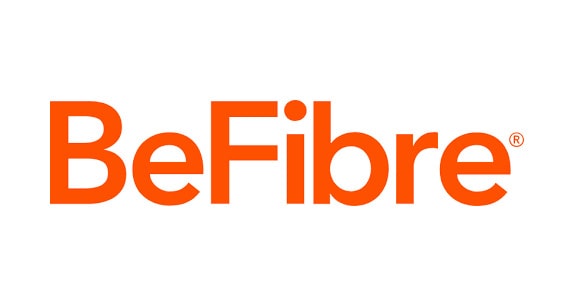Considering switching to BeFibre broadband?
In this article, we’ve reviewed BeFibre, to see if they’re any good, based on their download speeds, router, customer service, value for money, and more.
Let’s begin.
Contents
- BeFibre overview
- Coverage
- Speeds
- Wi-Fi router
- Phone packages
- Getting started with BeFibre
- Customer service
- Value for money
- Verdict: should you join BeFibre?
BeFibre overview
BeFibre is an independent full fibre broadband provider with coverage in certain areas of the UK.
BeFibre does not use the Openreach broadband network like most other fibre providers. Instead, they use the Full Fibre Limited network, which also supplies other providers like POP Telecom and IDNet.
As a result, you can only get BeFibre broadband in certain locations. We’ve discussed coverage areas in more detail below.
You can get download speeds of up to 2,300 Mbps with BeFibre, with symmetrical uploads included. Meaning, your upload speed will be the same as your download speed, no matter which plan you choose to buy.
Apart from broadband, you can also get a landline phone service using BeFibre’s BeTalk plan. They also offer a mesh WiFi service, available through their BeBoost WiFi add-on.
Each BeFibre broadband deal comes with a 24 month contract, and no upfront costs.
Coverage
Currently, you can get BeFibre in areas of Merseyside, Greater Manchester, Derbyshire, Essex, Staffordshire, Northamptonshire, and more.
Their coverage is good, but it’s not as good as the BT Openreach network, the Virgin Media network, or some other independent networks like Hyperoptic.
Go to the BeFibre website and put in your postcode to see if you can get their broadband service at your address.
Speeds
There are three broadband plans on offer from BeFibre at the moment:
- Be150: 150 Mbps download and upload speeds
- Be500: 500 Mbps download and upload speeds
- Be900: 900 Mbps download and upload speeds
- Be2300: 2,300 Mbps download and upload speeds
As we touched on before, BeFibre’s upload speeds are a lot faster than with most other major networks, such as Openreach or Virgin Media.
Your upload speeds will roughly match your downloads, which is quite rare at the moment – and is great if you’re often posting on social media, or work from home and often need to transfer large files.
BeFibre isn’t the fastest broadband provider in the UK – you can get up to 3 Gbps with Community Fibre in London.
However, 2,300 Mbps is more than plenty of bandwidth for most households. Even BeFibre’s 900 Mbps plan for example will allow you to download an HD movie in less than 30 seconds.
You can use our internet speed needs calculator to see what sort of download and upload speeds you might need for your household.
Wi-Fi router
Currently, BeFibre ships a Linksys Velop MX4000 router to new broadband customers.
The best thing about this router is it supports WiFi 6.wwad
This is a more modern WiFi standard than what many major providers’ routers – including BT and Virgin Media – offer at the moment.
As a result, with BeFibre’s Linksys router, you can get much better WiFi signal, especially at long range, or when dealing with obstacles, such as walls.
You get three gigabit Ethernet ports with the Velop MX4000, which is good, but some other routers offer four ports as standard. This isn’t an issue if you only need to connect a few devices to the router using a wired connection though.
BeFibre also offers a mesh WiFi add-on, for an extra monthly fee, giving you extra WiFi nodes to place around the house, to improve your signal.
This add-on can be quite useful if you have a large house. However, it’s not the best value – it’s quite expensive.
As a result, it would probably be better to buy mesh WiFI nodes separately, rather than committing to an extra monthly cost with BeFibre’s mesh add-on.
Phone packages
Many full fibre broadband providers no longer offer home phone services, so it’s good to see BeFibre that offers a digital telephone service, if you need a landline.
There’s only one voice package available, called BeTalk, which you can buy on a 24 month contract.
It includes unlimited anytime calls to UK landline and mobiles, for a pretty reasonable monthly cost, given what you’re getting.
For less frequent landline users, it would be good to see a pay as you go option, where you pay per minute for calls made, or an evening and weekends calling plan.
However, if you use your home phone all the time, BeFibre’s landline plan is great value for money.
Getting started with BeFibre
Since they operate a completely separate network from all other providers, getting started with BeFibre can be a bit more involved than switching to the likes of Plusnet or TalkTalk.
Fortunately, thanks to the recent introduction of one-touch switching, you most likely no longer need to contact your old provider to cancel your current connection.
Simply go to the BeFibre website and place an order, and they’ll begin the process of getting you up and running.
They’ll need to schedule an engineer visit, to get their equipment set up. You can pencil this in when you complete your order online – you’ll need someone at home on the day.
On the installation date, BeFibre’s technician will also deliver and install your router, saving you the hassle of doing it yourself, which is nice.
Sometimes, BeFibre will do pre-installation work outside your house, but you don’t need to be home for this, and you don’t need to worry about scheduling the work. You might see engineers in the street a few days before the installation date.
Generally, getting started with BeFibre is quite straightforward.
Just make sure to let them know if you can’t make your scheduled appointment on the day – otherwise, you might be charged a missed appointment fee.
Customer service
A few years ago, when they were just starting out, BeFibre had a number of issues with their service.
Some people experienced broadband dropouts, and had trouble resolving the problem by speaking to customer service.
Others had issues with the old Adtran router they used to ship and its firmware – it didn’t perform well when it came to WiFi signal.
Fortunately, BeFibre has addressed the majority of these issues.
Their new Linksys Velop router performs a lot better, and they no longer have issues with slow speeds and dropouts.
They’ve also improved their customer support processes, and their UK-based team is very responsive.
Some customers still do have issues with the installation process, but this is relatively normal for a full fibre broadband provider operating its own network, with a more involved setup process.
Overall, BeFibre currently has quite good customer service – not the best in the UK, but they’re doing a very good job given on the prices they’re charging.
Value for money
BeFibre’s biggest strength when compared to the likes of BT, Sky, EE, Hyperoptic, and Virgin Media, is their value for money.
On a cost-per-megabit basis, if BeFibre is available in your street (check here), they’re almost certainly the cheapest provider you can buy from.
Their 900 Mbps plan costs about the same as what you’d pay for 100-150 Mbps with BT. And their 100 Mbps deal is one of the cheapest broadband deals on the market at the moment, at any speed.
Also, BeFibre doesn’t charge any installation fees on any of their plans, nor do they hike prices mid-contract, like most of the major providers do.
BeFibre’s value for money is almost unbeatable. The only downside to this provider, pricing-wise, is their mesh WiFi add-on is a bit expensive, but you don’t have to include this option if you don’t want to.
Verdict: should you join BeFibre?
Overall, we rate BeFibre 4.3 out of 5.
They offer fast broadband, with very competitive monthly costs, and good customer service.
Their WiFi router is quite good, and there are no setup fees on any of their plans.
We just wish BeFibre’s coverage wasn’t so limited. Currently, they’re only available in certain parts of the UK.
Make sure to go to the BeFibre website and see if you can get their service at your address.
About the author

Tyler is the co-founder of Broadband Savvy. He has been helping people improve their broadband connectivity since 2018 by writing about fibre broadband and mobile broadband providers, as well as creating tutorials to help people improve their broadband speeds and Wi-Fi signal.
Tyler is responsible for the majority of buyer’s guides and broadband reviews published on Broadband Savvy. He has a wealth of experience testing and reviewing different broadband tariffs, including fibre internet plans, as well as 4G and 5G broadband deals. He is responsible for testing and evaluating Wi-Fi routers, performing speed and latency tests, and comparing the value for money of different broadband providers on the market in the UK.
Before co-founding Broadband Savvy, Tyler had a long history of tinkering with computers. He built his first PC at the age of 12, and since then, he’s become obsessed with all things networking and internet-related. He’s a massive gamer, loves Rocket League, and also plays Sunday League football.







Be aware that BeFibre don’t supply dynamic or static router IP addresses as standard. Their whole network uses CGNAT and static IPs are an additional £4/mo. They recommend paying extra if you want to use some VPNs. Port forwarding/DMZ doesn’t work. I was clearly mis-sold because I asked before switching and was told otherwise.
On the WAN side they use Google’s public DNS servers, not their own. DNS doesn’t seem to be available on the LAN side either so if you want that on your home network, you’ll have to set up your own DNS or use a different router.